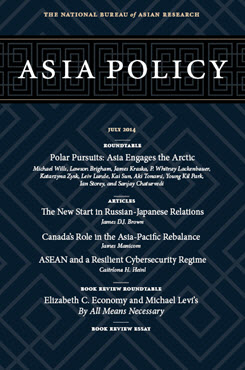Polar Pursuits
Asia Engages the Arctic
The ten essays in this Asia Policy roundtable are intended to illuminate the motivations and objectives of the new Asian observers and the reactions of the Arctic Council member states in an effort to understand the risks of geopolitical competition as well as the prospects of a maritime and energy renaissance in Arctic waters as the ice recedes.
Introduction
The Arctic could be completely ice-free during the summer months as early as 2020, with significant implications for global trade, energy security, and geopolitics (see Figure 1 for a map of the Arctic region). The warming Arctic climate could reduce shipping distances between Asia, North America, and Europe by thousands of miles; potentially make available for extraction hundreds of billions of dollars’ worth of energy and other resources; and create demand for advanced maritime and offshore technologies. Drawn by these opportunities, China, Japan, South Korea, India, and Singapore all applied for, and in May 2013 were granted, observer status in the Arctic Council—the intergovernmental forum that addresses Arctic issues. As the Arctic continues to open up, political and economic changes resulting from increased polar access have the potential to change maritime law, shift the balance of maritime economic power, and create disputes over sovereign rights as Arctic seabed resources become more accessible.
The ten essays in this Asia Policy roundtable are intended to illuminate the motivations and objectives of the new Asian observers and the reactions of the Arctic Council member states in an effort to understand the risks of geopolitical competition as well as the prospects of a maritime and energy renaissance in Arctic waters as the ice recedes. The roundtable begins with an overview by Lawson Brigham that examines the Arctic Council itself—the multilateral forum that for nearly two decades has provided a framework within which the eight Arctic countries, six delegations representing indigenous peoples, and various observers representing non-Arctic states, international organizations, and NGOs can manage international relations in the Arctic.
This overview is followed by a series of essays on perspectives from the Arctic Council member states—James Kraska on the United States, P. Whitney Lackenbauer on Canada, Katarzyna Zysk on Russia, and Leiv Lunde on the five Nordic states (Denmark/Greenland, Finland, Iceland, Norway, and Sweden)—that describe the varying expectations, hopes, and reservations about the new observers. These range from optimistic assessments about the benefits of broadening the circle of stakeholders working on Arctic issues to concerns from some states (Canada and Russia are noteworthy in this regard) about potential challenges posed by the diffusion of state sovereignty.
The roundtable concludes with five essays on perspectives from the new Asian observers. Kai Sun reviews the challenges China will face in attempting to reassure Arctic states about its intentions and set realistic expectations, both at home and overseas. Aki Tonami focuses on the opportunities Japan might have to strengthen relations with other Arctic states and observers, particularly those with which it is embroiled in territorial disputes elsewhere. Young Kil Park examines the predominantly economic opportunities South Korea sees in the region, not least as a potential boon to the country’s already strong shipbuilding sector. Ian Storey explains why Singapore—a city-state lying on the equator—has been so interested in charting an Arctic role for itself. And Sanjay Chaturvedi concludes the roundtable with an assessment of the energy and scientific opportunities that the Arctic offers to India.
As these authors all note, the changing environment in the Arctic presents both challenges and opportunities for policymakers and business leaders, especially in the energy and shipping sectors. In the United States, the Arctic is evolving from a narrow concern affecting Alaska, the Pacific Northwest, and parts of the national security establishment into an issue that attracts a broader level of interest, given the important strategic, energy, environmental, and maritime implications the opening of the Arctic holds.
This introduction was written by Michael Wills, Senior Vice President of Research and Operations at The National Bureau of Asian Research.
The Changing Arctic: New Realities and Players at the Top of the World
Lawson Brigham
Asian States in U.S. Arctic Policy: Perceptions and Prospects
James Kraska
Canada and the Asian Observers to the Arctic Council: Anxiety and Opportunity
P. Whitney Lackenbauer
Asian Interests in the Arctic: Risks and Gains for Russia
Katarzyna Zysk
The Nordic Embrace: Why the Nordic Countries Welcome Asia to the Arctic Table
Leiv Lunde
Beyond the Dragon and the Panda: Understanding China’s Engagement in the Arctic
Kai Sun
Future-Proofing Japan’s Interests in the Arctic: Scientific Collaboration and a Search for Balance
Aki Tonami
South Korea’s Interests in the Arctic
Young Kil Park
The Arctic Novice: Singapore and the High North
Ian Storey
India’s Arctic Engagement: Challenges and Opportunities
Sanjay Chaturvedi
About Asia Policy
Asia Policy is a peer-reviewed scholarly journal presenting policy-relevant academic research on the Asia-Pacific that draws clear and concise conclusions useful to today’s policymakers. Asia Policy is published quarterly in January, April, July, and October and accepts submissions on a rolling basis. Learn more


